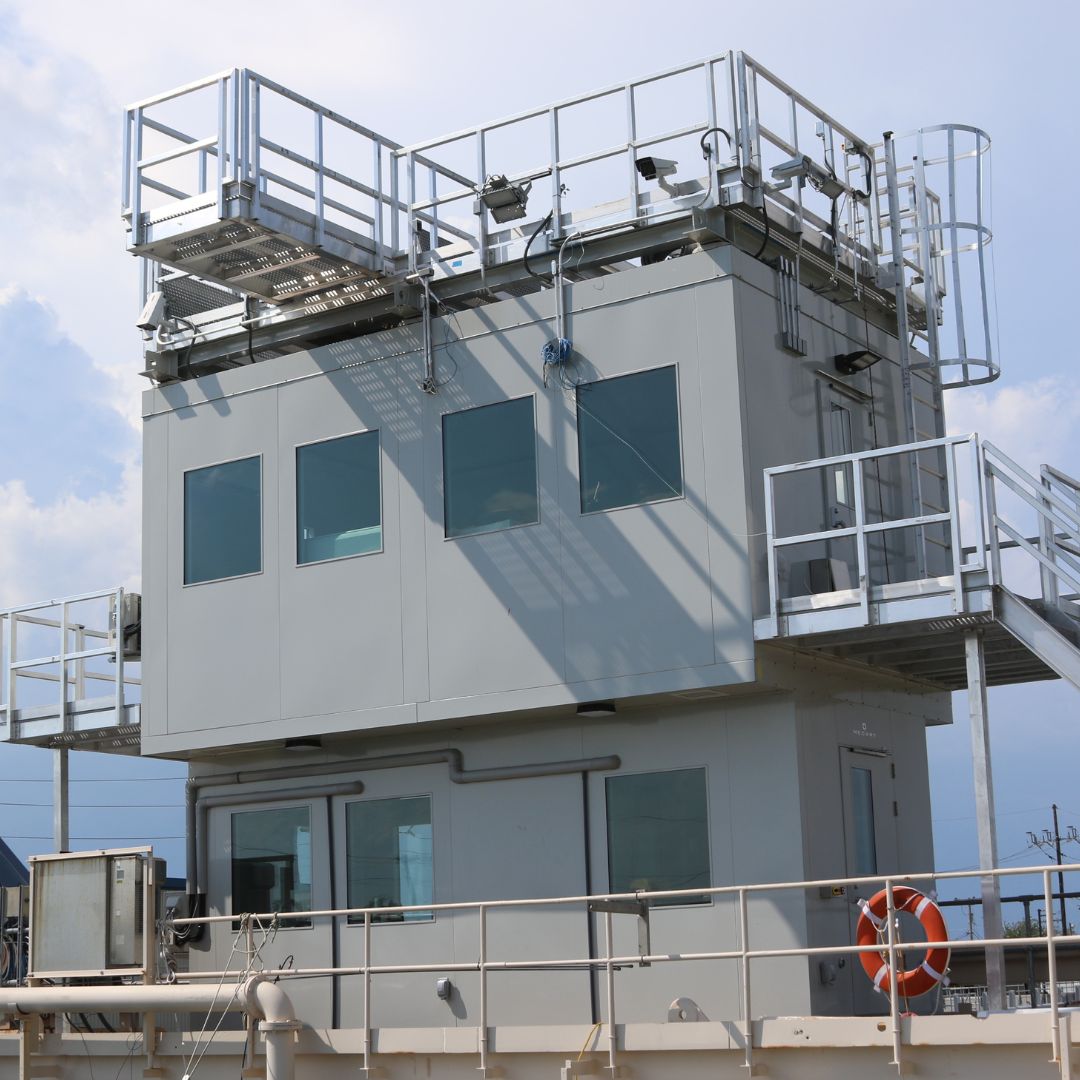Article last modified on: 2025-10-10
Co-written and supervised by acoustic expert Jean-François Latour
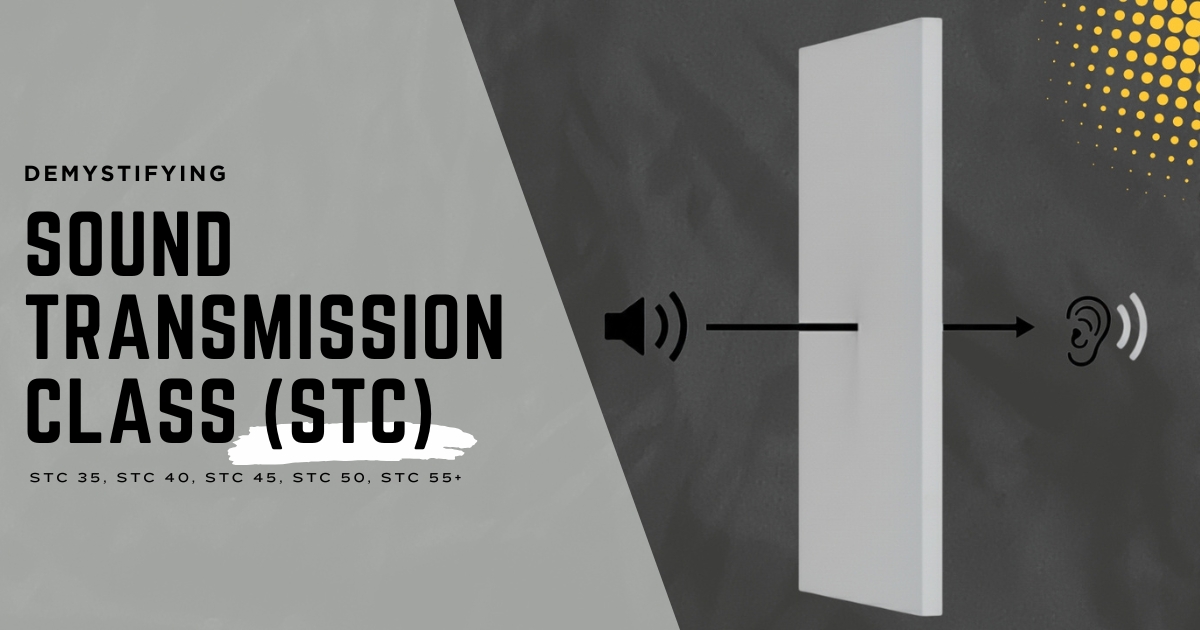
Demystifying Sound Transmission Class (STC Ratings)
When you’re designing a control room, studio, operator cabin, or acoustic enclosure, one question always comes up: How much sound isolation do you need? In North America, that answer often starts with Sound Transmission Class (STC)—but what does the number actually mean for your project? STC 35, STC 40, STC 45, STC 50, and STC 55 are common benchmarks. Here’s what STC measures, how it’s determined, what these ratings mean in real-world use, and how to choose the right level for your space.
What you’ll learn: what Sound Transmission Class (STC) is, how it’s measured, what each rating typically blocks, and how to select the right STC for your application—so you can make confident, effective decisions about sound isolation and soundproofing.
What is Sound Transmission Class (STC)?
STC stands for Sound Transmission Class. It is a rating system that classifies the airborne sound isolation provided by a building element/partition. Simply put, STC is a single-number rating classifying soundproofing.
- It allows you to qualify a single number rating for how much sound a wall, door, window, etc., will block from getting out of a room and being transmitted to another (or vice versa).
- STC is the most common rating system for airborne sound isolation in North America.
What influences the STC rating?
- The STC rating depends on the composition of the building element/partition that separates the two rooms.
- The building element could be composed of a single material or several.
- In general, a partition with more mass will provide greater STC ratings (mass law).
- Multiple-layer assembly (double leaf, triple leaf, etc.) with a separating insulation-filled gap may increase the performance in some frequency bands.
- The incorporation of damping material and/or resilient material will also improve STC rating (decoupling).
In simpler words, Sound Transmission Class is a single number rating metric for a building partition based on its ability to reduce sound passing through it. STC measures how well the partition blocks sound transmission. But what do these numbers actually tell us about a material’s real-world performance? Does a higher STC always mean better soundproofing?
Sound Transmission Class (STC) was introduced in 1961 by the American Society for Testing and Materials (ASTM) as a standard way to measure and compare the sound-blocking ability of building elements such as walls, floors, doors, and windows.
Does a Higher or Lower STC Rating Provide Better Soundproofing?
The higher the STC rating number is, the better the soundproofing performance. Think of it like a barrier’s ability to block noise: as the STC number increases, more noise is prevented from passing through the material.
For example, a wall with an STC rating of 60 offers better sound isolation than one rated at 30. To put this in familiar terms, imagine STC ratings like sunscreens’ SPF number:
- Higher STC = higher SPF, more protection against the sun’s rays (better at blocking sound).
- Lower STC = lower SPF, more sunburn risk (lets more sound through).
Before we dive into how STC ratings are calculated, let’s start with a simple visual explanation of what STC means for soundproofing. The Sound Transmission Class table below, inspired by the one from Mecanum, a manufacturer of noise and vibration control instruments, shows how different STC ratings perform.
Sound Transmission Class (STC) Chart vs Perception
These STC ratings are subjectively described and put in perspective with one another.
Perceived loudness varies with many factors: the noise source’s spectrum (broadband, tonal, or impulsive), its rhythmic/temporal character, sound directionality (angle of incidence), background noise in the receiving room, listeners’ hearing, and room/environmental conditions.
Because of this, values in Sound Transmission Class (STC) charts are guides—not guarantees. Always interpret them in the context of your specific space and use case. For example, an STC that’s acceptable for an office may be inadequate for a bedroom or a recording studio. Also note that building codes and authorities having jurisdiction (AHJs) may set minimum STC requirements you must meet.
!It’s important to approach generic STC charts online with caution
Many offer oversimplified or inaccurate information that can mislead users about what constitutes effective soundproofing and what levels of noise are actually perceptible.
✔ Always consult acoustic experts when planning for sound isolation, as real-world performance depends on many variables.
✔ There’s a big difference between the STC rating of a single component (such as a window) and the overall sound isolation of a constructed building.
✔ STC ratings alone do not define total sound isolation of a finished space. Other measurements like ASTC may provide a clearer picture.
But before comparing sound isolation metrics like ASTC and NIC, it’s critical to understand how STC ratings are tested and what they actually measure. Field performance can differ from lab-based results—knowing this prevents misinterpretation and ensures your project meets both regulatory standards and real-world acoustic needs.
How is the Sound Transmission Class (STC) Rating Determined?
First, it’s important to know that Sound Transmission Class is measured inside a laboratory. Typically, if a building element is rated with an STC number, the element has been laboratory tested, and a report should be available to support the STC result.
Per ASTM E90, airborne Sound Transmission Loss (STL) is measured in one-third-octave bands (typically 125–4,000 Hz) under controlled conditions (flanking control, calibrated instrumentation, defined source/receive rooms).
Those data are then fit to the STC reference contour per ASTM E413, producing the single-number STC.
- ASTM E90: Standard Test Method for Laboratory Measurement of Airborne Sound Transmission Loss of Building Partitions and Elements
- ASTM E413: Classification for Rating Sound Insulation
In short: E90 defines how the test is run; E413 defines how the results are classified into an STC number.
Note: STC is a lab rating; field results (e.g., ASTC per ASTM E336) can differ due to installation and flanking.
Testing, Measuring & Analyzing: Collecting the Sound Transmission Class Data
Now that we’ve covered the theory behind STC and the standards that define it, let’s look at what the testing process actually involves. Determining an STC rating requires a carefully controlled setup, precise measurements across frequencies, and a standardized analysis method. The process can be broken down into three main stages: testing setup, measurement, and data analysis. Here is a high-level description of the process to determine the STC rating of building elements such as walls, windows, doors, etc.
1. STC Testing Setup:
- Two adjacent rooms are separated by the building element being tested.
- One room is designated as the source room, where sound is generated.
- The receiving room measures the sound transmitted through the element.
2. STC Measurement Process:
- Sound pressure levels are measured in both rooms using specialized instrumentation (sound level meter, microphone, etc.).
- The sound pressure levels are measured at various frequencies (at a minimum from 125 Hz to 4 kHz).
- Sound Transmission Loss (STL) is calculated by comparing sound pressure levels between source and receiving rooms, factoring in the tested element’s surface area and the receiving room’s absorption.
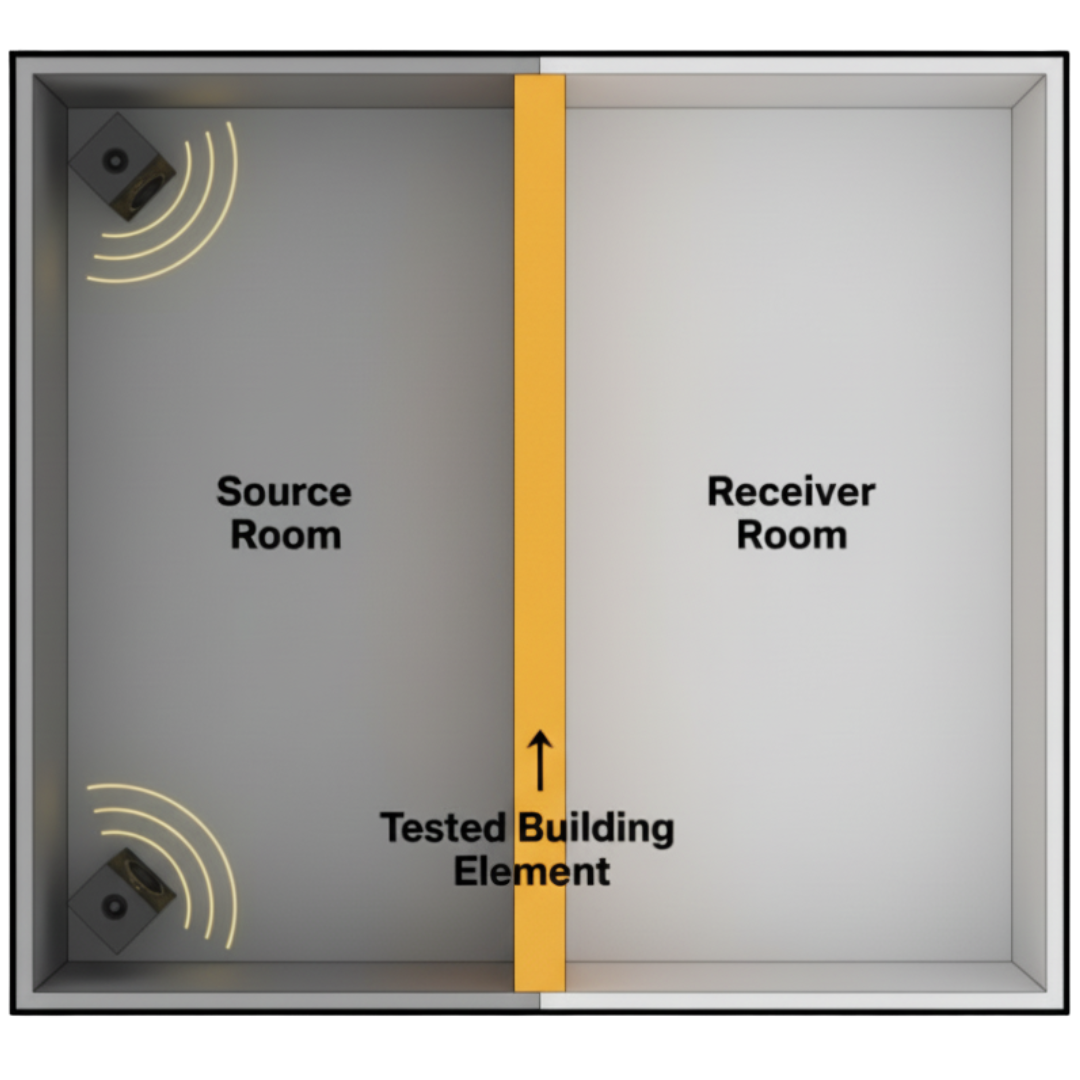

3. Analyzing & Transforming the Data Into a Sound Transmission Class Rating:
- Sound Transmission Loss values are plotted on a graph.
- These STLs are compared to a classification curve following the algorithm defined by ASTM E413.
- The STC rating is the output number of the classification algorithm.
Now that we’ve explored how STC ratings* are measured and determined, we will focus on analyzing and explaining the results of a comparative STC analysis for different types of assembly.
*One caveat: As powerful as STC is to classify soundproofing a single number rating, STC does not convey information on the specific performance per frequency.
A soundproofing system with a high STC rating may be effective at blocking high-frequency noise, but not low-frequency noise, and vice versa, as illustrated on the sound transmission loss graph.
Plan the Right STC for Your Build
Clear specs, modular panel STC ratings, and application guides inside the brochure.
Sound Transmission Loss and STC Rating Example: Understanding the Results
The graph below compares the sound isolation performance of the MECART standard panel with two common construction assemblies: drywall partitions and concrete blocks. As a reminder, a higher STC number indicates better sound isolation.
In this case, the MECART panel performs about the same as drywall in the mid and upper-mid frequencies (630–2,000 Hz) and outperforms it at both low and high frequencies. Against this concrete block assembly, it shows nearly identical results from 125–1,600 Hz—but at a fraction of the weight: 7 lbs/ft² compared with 48 lbs/ft². This lighter surface mass makes installation easier while maintaining comparable performance.
STC Chart: Comparison Between MECART Standard Panels VS Common Construction Assemblies
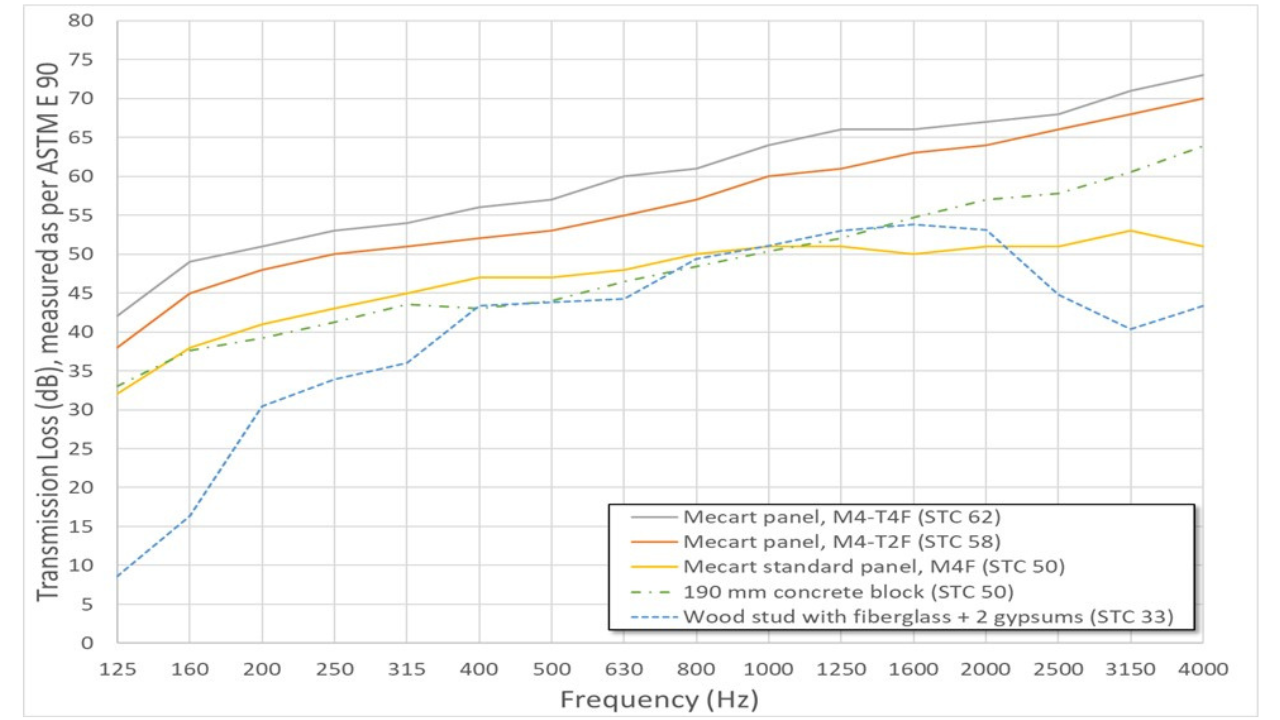
Figure 1: Transmission Loss (dB) of MECART panels compared with drywall and concrete block assemblies, measured per ASTM E90.
It’s important to note, however, that STC is only part of the story. While it remains the most widely used benchmark, laboratory-tested STC values don’t always reflect real-world performance, where factors like installation quality, flanking paths, and actual room conditions come into play.
That’s where Apparent STC (ASTC) and Noise Isolation Class (NIC) come in. Closely related to STC, these metrics extend the picture by measuring how well sound is contained under actual building conditions, providing a more complete view of room-to-room isolation.
In the next section, we’ll look at how STC, ASTC, and NIC connect, where they differ, and why these distinctions matter when designing spaces that must reliably achieve their acoustic goals.
STC vs. ASTC vs. NIC: How Are They Different, and Why Does It Matter?
When it comes to soundproofing, not all ratings are made for the same purpose/application. You’ll often see these three terms: STC (Sound Transmission Class), ASTC (Apparent Sound Transmission Class), and NIC (Noise Isolation Class). They might seem similar, but each one tells a slightly different story about soundproofing.
What These Ratings Have in Common
- All three ratings are single numbers designed to make it easy to compare the sound-blocking ability of different walls or assemblies.
- In all these cases, the higher the number, the better the sound isolation—which means less noise travels from one room to another.
- They’re all used in building design to set standards and expectations for acoustical comfort.
Note that, depending on the territory, some Code requirements or Authority Having Jurisdiction may refer to one or several of these metrics. However, STC and ASTC are the more frequent ones.
STC vs. ASTC: Lab vs. Reality
STC
STC is a lab rating. It measures how much sound gets through a wall or floor under perfectly controlled conditions. It does not account for sound sneaking around the wall (like through gaps, ceilings, or adjacent structures).
ASTC
ASTC is measured in real buildings. It measures not only the wall itself, but also those “flanking paths” where sound can slip through other routes. As a result, ASTC ratings are typically lower than STC for the same wall composition, but they’re a better predictor of what you’ll actually hear in a finished space.
In short:
STC is what the wall “could” do at its best; ASTC is what it actually does after construction, with all real-world imperfections.
STC vs. NIC: Assembly vs. Specific rooms
STC
STC relates to the performance of the assembly. It is influenced mainly by the assembly composition and is independent of the acoustic environment of either side or its area. This makes it practical: the value is assembly-specific and doesn’t change with location or room traits.
NIC
NIC measures the total sound transmitted between two rooms, capturing every possible path—walls, doors, windows, even air leaks. It’s measured after everything is finished and in use. Driven by in-room absorption and the common wall area, it’s specific to the adjoining rooms tested—so results don’t extrapolate well to different setups (room size, etc.).
In short:
STC ≈ R-value for acoustics: tied to the assembly, not its dimensions or site. NIC ≈ the measured temperature difference across a particular building, accounting for all conditions.
How to Determine Your Required STC Performance?
Selecting the perfect Sound Transmission Class (STC) rating isn’t a guesswork. It’s about aligning your space’s specific function with the noise it faces and your desired level of quietness. Follow these steps to ensure your soundproofing investment delivers optimal and cost-effective results:
Bottom Line: Determining Your Required Sound Transmission Class (STC):
Determining the right STC rating is a blend of science, practical application, and meticulous execution. By following these steps, you ensure your soundproofing investment delivers the comfort, privacy, and compliance your space genuinely demands.
Now, let’s apply these principles to typical workplace environments. What are the recommended STC ratings for different settings?
Need Help Determining Your Soundproofing Needs?
We are here to help and guide you towards the ideal solution, without any pressure.
Recommended STC Ratings for the Workplace
Selecting an appropriate STC rating depends on your environment and your acoustic objectives. Below are typical recommendations for a range of settings, including industrial facilities, office spaces, and professional studios:
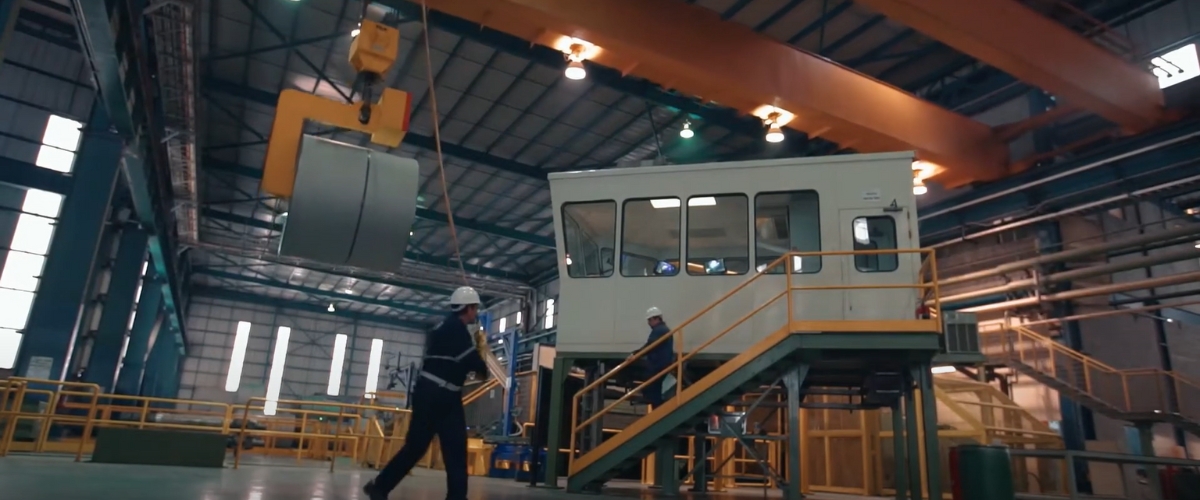
Recommended STC Ratings for Industrial Noise Control
The recommended STC ratings for industrial noise typically range from STC 35 to STC 55+, depending on the environment’s needs.
This level of soundproofing helps ensure compliance with safety regulations, protects workers from noise-related hazards, and improves communication and productivity in the workplace.
Recommended STC Ratings for Professional Studios
For professional-quality audio and recordings, aim for a studio with a high Sound Transmission Class (STC) rating of 50-65+.
This level of sound isolation effectively blocks most outside noise, resulting in cleaner and crisper audio that enhances post-production editing and adheres to industry standards.

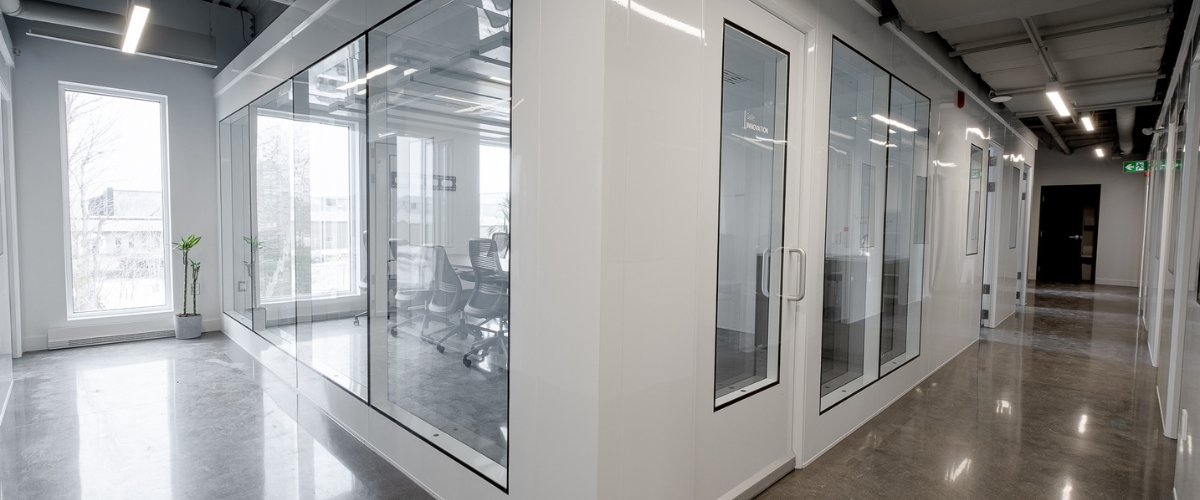
Recommended STC Ratings for Normal Office Spaces
According to WELL guidelines, the recommended STC ratings for office partitions typically fall between STC 40 and STC 45, depending on the desired level of privacy and the background noise in the receiving space, and STC 53 for conference rooms.
STC 35, STC 40, STC 45, STC 50 Applications & Examples
To give you a clearer picture, here’s how various STC ratings translate to real-world assemblies and applications:
STC 35: Basic Sound Transmission Loss (Soundproofing)
STC 35 assemblies provide moderate sound reduction, helping to limit—but not entirely block—the transfer of everyday household or industrial sounds. This rating is common for for interior partition for single-unit residences, as well as in industrial settings where basic noise management helps keep exposure below hazardous thresholds.
Project and Application Examples:
- Interior partitions in single-unit homes
- Operator cabins in mills
- Control rooms in light manufacturing facilities
STC 40: Average Sound Transmission Loss (Soundproofing)
STC 40 assemblies provide a noticeable improvement in sound isolation, offering better speech privacy and greater control over external noise compared to STC 35. This rating is common in environments where a higher degree of acoustic comfort is needed, though additional soundproofing may still be required for more demanding applications.
Project and Application Examples:
- Basic office partitions
- Enclosures for light industrial workspaces or equipment rooms
STC 45: Good Sound Transmission Loss (Soundproofing)
Each 5-point increase in STC brings a noticeable improvement, and STC 45 delivers significantly better isolation than both STC 40 and STC 35, especially since sound transmission works on a logarithmic scale. Assemblies at this level provide very good sound reduction in environments where minimizing distraction, ensuring privacy, or maintaining safety is essential.
Project and Application Examples:
- Modular in-plant offices for paper manufacturing
- Hospital patient rooms
- Control rooms in aluminum foundries
- Operator cab in copper anodes refinery
STC 50+: Superior Sound Transmission Loss (Soundproofing)
Assemblies rated STC 50 and above provide outstanding sound isolation, making them suitable for the most demanding acoustic environments, such as steel mills, mining sites, and high-noise manufacturing facilities. STC 50 is also considered the basic minimum threshold for some professional recording studios and critical audio spaces.
Project and Application Examples:
- Minimum residential party walls
- Video editing and voice-over studios
- Recording studios (e.g., SiriusXM broadcast complexes, STC 55+)
- Broadcast studios (e.g., modular studios with STC 56)
- Control booths for smelting or heavy industry (STC 52+)
- Hotel suites
- Control rooms in high-noise industrial settings
- Music practice rooms
- Music production suites
Reduce noise. Protect people. Boost productivity.
Make confident, efficient choices on sound isolation. Get the right STC for your environment—
sized to your noise sources, receivers, and real-world constraints
No spam—just practical guidance to reach the right STC with real-world constructability.
Conclusion: Choosing the Right STC Rating for Your Project
Ultimately, selecting the right STC rating comes down to understanding your space, your goals, and the specific challenges you face. Here’s what to keep in mind:
- Understanding Sound Transmission Class (STC) ratings is crucial for selecting effective soundproofing solutions across various settings, from control rooms to studios and industrial enclosures.
- Higher STC ratings generally offer better sound isolation, but it’s essential to consider specific noise sources, frequencies, and the environment where the soundproofing will be applied.
- The right combination of materials, construction methods, and acoustic expertise ensures optimal sound control tailored to your project’s unique requirements.
At MECART, we deliver customized noise control solutions that bridge the gap between lab-tested STC ratings and real-world performance with our prefabricated panelized system, hence providing reliable and consistent sound isolation.
If you need guidance on selecting the best STC rating for your space, our team of acoustic experts is ready to help. Contact us today to learn more about our products and find the perfect solution for your soundproofing needs.
